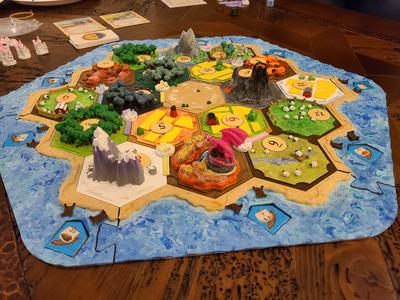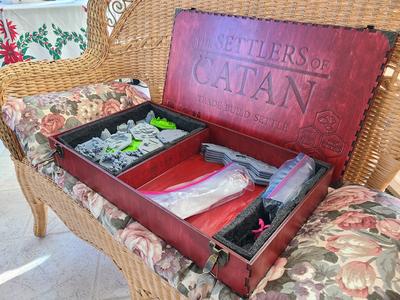Custom Catan Board: Difference between revisions
No edit summary |
No edit summary |
||
| Line 11: | Line 11: | ||
* Laser cutting the box | * Laser cutting the box | ||
* Gluing the box together | * Gluing the box together | ||
* Painting the box | * Painting the box (ensure this is done AFTER gluing, otherwise, you might chip the paint, or the glue won't be as strong) | ||
* Lining the box | * Lining the box (this is not necessary, but might help save the pieces from breaking) | ||
* Decorating the box | * Decorating the box | ||
* Painting the game pieces | * Painting the game pieces | ||
| Line 37: | Line 37: | ||
The color of the pieces does not matter much if you are painting over the pieces. The best options are either to try and match the printing material color with the desired painted color, or use a neutral color like a light grey or white that paints over easily. | The color of the pieces does not matter much if you are painting over the pieces. The best options are either to try and match the printing material color with the desired painted color, or use a neutral color like a light grey or white that paints over easily. | ||
I'd recommend at least planning the box, if not working on it while the pieces are printing as this will be a lot of waiting. | |||
Check the pieces as they are being printed to see if they need to be reprinted. Some pieces (especially the sheep with trees) might have parts that fall off, like the tree tops. These flaws don't require a reprint as the pieces still look good, but that is up to you. | |||
For each hex tile, you will need to use wire cutters to snip off the circles around the corners that are printed to reduce warping. You will also likely need to sand down all the bottom edges of the hex tiles for the pieces to fit snuggly in the water borders. | |||
== Planning the Box == | |||
Revision as of 19:40, 20 March 2022
Build Overview
This page documents the creation of a 3D printed Catan board and custom box for storing the pieces. This project involves 3D printing the many board game pieces, woodworking to create the box, wood painting, and figuring painting. This project is based on an online Instructables tutorial.
The build can be broken down into a few different steps:
- 3D printing the pieces
- Laser cutting the box
- Gluing the box together
- Painting the box (ensure this is done AFTER gluing, otherwise, you might chip the paint, or the glue won't be as strong)
- Lining the box (this is not necessary, but might help save the pieces from breaking)
- Decorating the box
- Painting the game pieces
Printing the Pieces
The 122 different pieces you will need are:
- 1x desert tile
- 1x each of the hill/brick tiles (3 total)
- 1x each of the mountain/ore tiles (3 total)
- 1x each of the pasture/wool titles (4 total)
- 1x each of the forest/lumber tiles (4 total)
- 1x each of the field/grain resource (4 total)
- 6x water borders
- 16x citys (4 for each player)
- 20x settlements (5 for each player)
- 60x roads (15 for each player)
- 1x dragon
Most of these pieces can be found on the Instructables webpage, but the water border pieces can be found here.
It will be a long process of printing all the pieces as the best option is to print most of them individually as they are prone to error or slight printing issues. I have found that it is possible to print many of the settlements, cities, and roads together using the sequential print option. This can be found in the Custom print settings page, if you search "print sequence", you can change the option to "one at a time". This makes the printer completely finish one piece before starting on the next. This will stop mistakes from happening with the nozzle quickly moving between the different pieces. However, this will limit how many you can print at once.
Luckily, the infill only really needs to be at 5% since they do not need to be insanely sturdy. The layer height can be .2mm for the hex tiles and water pieces and .1mm for the dragon, cities, settlements, and roads. The only piece that will need support is the dragon, however you will likely want to use dissolvable support PVA as ripping PLA support off can damage the pieces. In total, the printing time will be somewhere around 75-100 hours, depending on the running variables.
The color of the pieces does not matter much if you are painting over the pieces. The best options are either to try and match the printing material color with the desired painted color, or use a neutral color like a light grey or white that paints over easily.
I'd recommend at least planning the box, if not working on it while the pieces are printing as this will be a lot of waiting.
Check the pieces as they are being printed to see if they need to be reprinted. Some pieces (especially the sheep with trees) might have parts that fall off, like the tree tops. These flaws don't require a reprint as the pieces still look good, but that is up to you.
For each hex tile, you will need to use wire cutters to snip off the circles around the corners that are printed to reduce warping. You will also likely need to sand down all the bottom edges of the hex tiles for the pieces to fit snuggly in the water borders.

